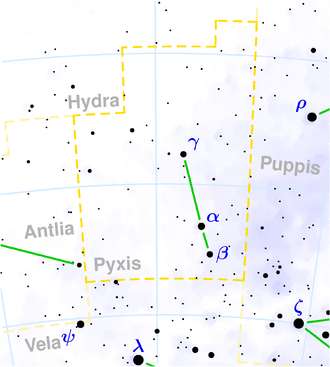NGC 2613
| Galaxy NGC 2613 |
|
|---|---|

|
|
| ESO : Image taken with the Very Large Telescope | |
| AladinLite | |
| Constellation | Ship compass |
|
Position equinox : J2000.0 , epoch : J2000.0 |
|
| Right ascension | 08 h 33 m 22.8 s |
| declination | -22 ° 58 ′ 25 ″ |
| Appearance | |
| Morphological type | SA (s) b / HII |
| Brightness (visual) | 10.4 mag |
| Brightness (B-band) | 11.2 mag |
| Angular expansion | 6.5 'x 1.4' |
| Position angle | 113 ° |
| Surface brightness | 12.6 mag / arcmin² |
| Physical data | |
| Redshift | 0.005591 ± 0.000010 |
| Radial velocity | 1676 ± 3 km / s |
|
Stroke distance v rad / H 0 |
(66 ± 5) x 10 6 ly (20.1 ± 1.4) Mpc |
| history | |
| discovery | Wilhelm Herschel |
| Discovery date | November 20, 1784 |
| Catalog names | |
| NGC 2613 • UGCA 141 • PGC 23997 • ESO 495-018 • MCG -04-21-003 • IRAS 08311-2248 • 2MASX J08332284-2258252 • SGC 083111-2248.1 • GC 1674 • H II 266 • h 3129 • HIPASS J0833- 22 • AM 0831-224 | |
NGC 2613 is a spiral galaxy of the Hubble type Sb in the constellation Ship Compass in the southern sky . It is estimated to be 66 million light years from the Milky Way and about 140,000 light years in diameter.
The object was discovered by Wilhelm Herschel on November 20, 1784 .
